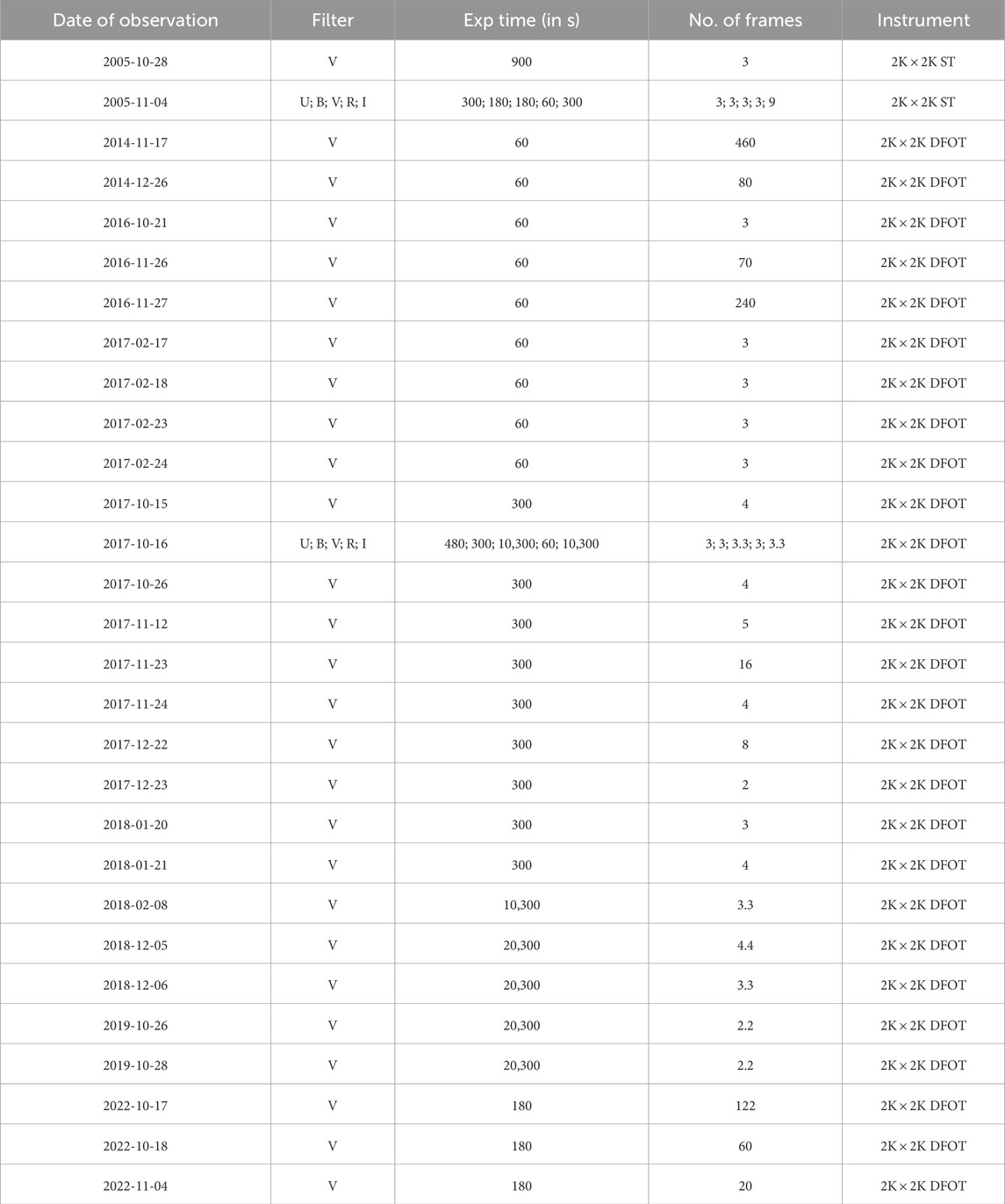- 1Department of Astronomy and Astrophysics, Aryabhatta Research Institute of Observational Sciences (ARIES), Nainital, India
- 2Department of Applied Physics/Physics, M.J.P. Rohilkhand University, Bareilly, India
- 3Department of Astronomy and Astrophysics, Tata Institute of Fundamental Research (TIFR), Mumbai, India
- 4Department of Physics, Indian Institute of Technology (IIT) Roorkee, Roorkee, India
- 5Department of Applied Physics/Physics, Bareilly College, Bareilly, India
We present a decade-long investigation of a poorly studied cluster, Berkeley 65 (Be 65), using deep optical data from the telescopes of ARIES, Nainital Observatory. We estimate its radius (
1 Introduction
Most stars are believed to form in clusters within molecular clouds (Lada and Lada, 2003) and are ideal sites to study star formation and stellar/galaxy evolution. The mass function distribution in a cluster (having a broad mass range) is an ideal statistical tool to investigate the star formation process. The dynamics of stars in the clusters, as well as the structure of clusters measured as a function of cluster age, hold important clues on the processes of galaxy evolution. The long-term monitoring of stars in the cluster also gives important clues on the internal physical processes related to their evolution, through their photometric variability behavior (Lada and Lada, 2003; Allen et al., 2007; Grasha et al., 2017; Grasha et al., 2018).
The star clusters, which are primarily formed in the Galactic disc, are subjected to disturbance, such as disc shock, spiral arm passage, molecular cloud encounters, etc., (Spitzer and Harm, 1958; Kruijssen, 2012). As star clusters evolve, the removal of gas due to stellar feedback, along with gravitational interactions among stars and binary systems, gradually weakens the cluster’s gravitational potential. This process results in the expansion of the cluster and can ultimately lead to its partial or complete dissolution into the surrounding galactic field (e.g., Spitzer and Harm, 1958; Dib et al., 2011; Parker and Meyer, 2012; Dib et al., 2013; Parker and Dale, 2013; Pfalzner and Kaczmarek, 2013; Brinkmann et al., 2017; Dib et al., 2018). In the Galactic disc, open clusters typically have a lifespan of approximately 200 Myr before they begin to break apart (Bonatto et al., 2006; Yang et al., 2013). Clusters that survive beyond this period often develop distorted shapes and become less tightly bound, increasing their likelihood of breaking apart. After breaking apart, these former clusters give rise to moving groups and add stars to the field population (see also, Sharma et al., 2020). Thus, open clusters are the sites to study the galaxy’s evolution and dynamics (Tang et al., 2019).
Open clusters also harbor various types of variable stars, including pulsating, rotating, eclipsing binaries, and non-periodic variables, in a broad mass spectrum. Pulsating variables, such as
Thus, considering the above points, an intermediate-age open cluster (a few 100 Myr age, having most of the stars in the main sequence) located in the Galactic plane is ideally suited to study the dynamics and stellar evolution simultaneously. Similar studies on star clusters have been carried out in the past decade. However, most of these studies are not always based on deep and long-term photometric data and usually lack membership determination based on high-quality proper motion (PM) data. This paper presents a photometric study of a poorly studied open cluster, Berkeley 65 (hereafter, Be 65; Figure 1). Be 65 is a Trumpler Class I 2p open cluster (Ruprecht, 1966) in Cassiopeia constellation, located at
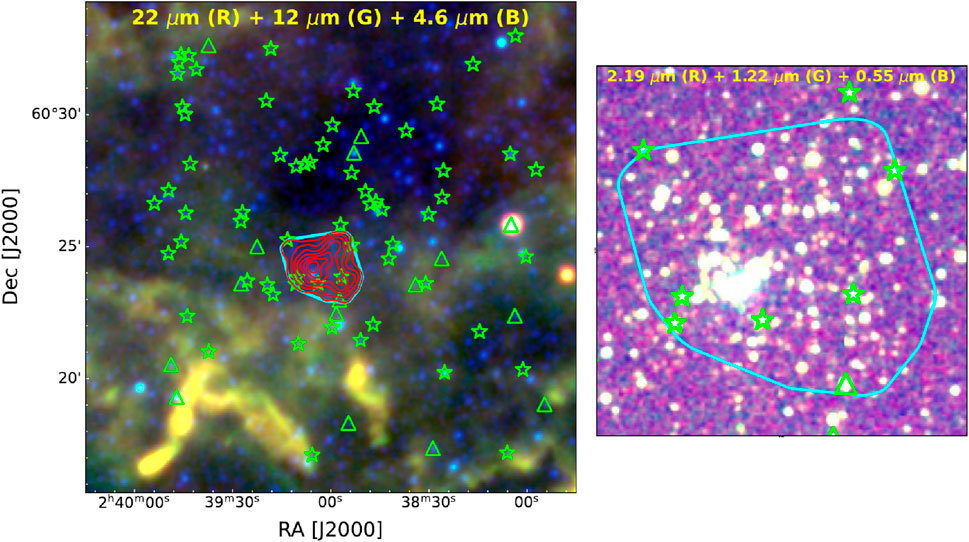
Figure 1. Left panel: Color composite image of the Be 65 cluster region covering
This paper is organized as follows: Section 2 presents the observations and data reduction. Section 3 outlines the methods used to derive the cluster parameters and identify variable stars. In Section 4, we discuss the physical and dynamical properties of the cluster Be 65, as well as the characteristics and classification of the identified variables. Finally, Section 5 provides a summary of our findings and conclusions.
2 Observations and data reduction
2.1 Optical photometric data
The long-term photometric monitoring of Be 65 was done using the 1.3 m f/4 Devasthal Fast Optical Telescope (DFOT) at the Aryabhatta Research Institute of Observational Sciences (ARIES), located at Devasthal, India. The telescope has a 2K
The basic data reduction, including image cleaning, photometry, and astrometry, was done using the standard procedure explained in Sharma et al. (2020) and Kaur et al. (2020). The Be 65 field was observed on the same night (04 November 2005) as was NGC 6910 cluster (Kaur et al., 2020) along with a standard field (SA98, Landolt, 1992). The typical seeing value on that night was
2.2 Archival photometric data
We have also used the photometric point source catalog from the following archives:
1. We obtained near-infrared (NIR) JHKs photometric data from the 2MASS All-Sky Point Source Catalog (Cutri et al., 2003; Skrutskie et al., 2006) for a stellar distribution study (see Section 3.1). This catalog provides complete and reliable NIR photometry down to the 15.8, 15.1, and 14.3 magnitude limits in J (1.24
2. We have used data from Gaia’s third data release, Gaia DR3 (Gaia Collaboration et al., 2023). Gaia DR3 provides astrometric positions, parallaxes, radial velocities, and proper motions for over 1.8 billion sources brighter than 21 mag in the G (0.33-1.05
3 Methodology
3.1 Structure of the cluster
As stars are less attenuated by dust and gas in NIR bands in comparison to optical bands, we have used the 2MASS All-Sky Point Source Catalog to investigate the distribution of stellar density in the Be 65 region, covering
where
The resulting density contours, shown as red curves in the left panel of Figure 1, have the lowest contour level set at 1
3.2 Extinction, distance, and age of the cluster
We have used an optical
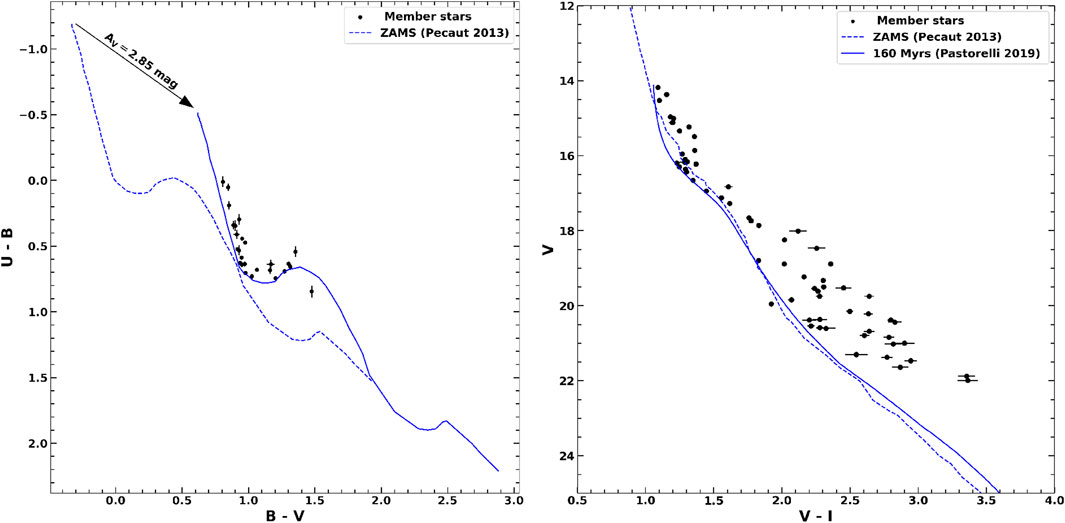
Figure 2. Left panel:
To calculate the distance of the Be 65 cluster, we have selected 11 relatively brighter (V
The ages of young clusters are typically estimated using dereddened CMDs, either by comparing the most massive stars with post-main-sequence evolutionary tracks, if significant stellar evolution is evident, or by fitting PMS isochrones to the lower-mass, still-contracting population (Phelps and Janes, 1994; Lata et al., 2014a; Sharma et al., 2020; Rangwal et al., 2023; Verma et al., 2023). The brighter blue stars typically serve as key constraints in isochrone fitting (Phelps and Janes, 1994). To determine the age of Be 65 cluster, we utilized the optical CMD (V versus V–I), presented in the right panel of Figure 2 (Lata et al., 2014b; Sharma et al., 2020; Rangwal et al., 2023). The ZAMS (Pecaut and Mamajek, 2013), corrected for the cluster’s distance and reddening, is overlaid as a dashed blue curve. The brightest star on the main sequence has an estimated mass of approximately 3.5
3.3 Mass function
The distribution of stellar masses during a star formation event is known as the initial mass function (IMF). The study of the IMF is crucial for understanding the star formation process and star clusters’ subsequent chemical and dynamical evolution (Kroupa, 2002). However, directly determining the IMF for a cluster is not possible due to the dynamic evolution of the stellar system. Therefore, we have estimated the present-day mass function (MF) of the Be 65 cluster. The MF is commonly represented by a power law equation,
Where
To estimate the CF, we used the ADDSTAR routine from DAOPHOT II (Stetson, 1987; Stetson, 1992). The detailed methodology is described in Sagar and Richtler (1991). In summary, artificial stars with known magnitudes and positions were randomly added to the original image. These modified frames were then re-reduced using the same reduction procedures as the original data. The CF as a function of magnitude was determined by calculating the ratio of recovered artificial stars to the total number of added stars within each magnitude bin. To better sample the fainter end of the luminosity function, a more number of artificial stars were added in the lower magnitude ranges. The number of added stars was limited to approximately 15
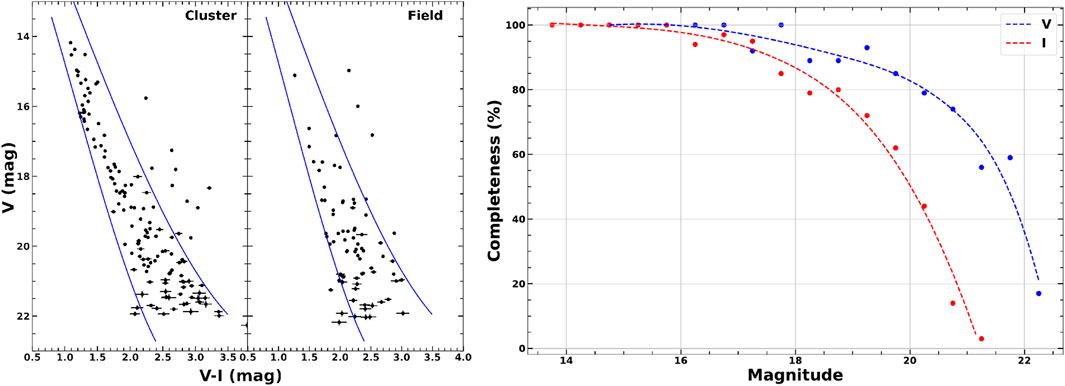
Figure 3. Left panel:
The left panel of Figure 3 presents the CMDs for stars in both the cluster and field regions. We defined an envelope to select well-defined MS stars in each region (cf. Sharma et al. 2008), to reduce field star contamination in the cluster region. To construct the cluster’s luminosity function (LF), we subtracted the CF-corrected star counts in the field region from those in the cluster region, in different mag bins within the envelopes in the CMDs. Finally, the magnitude bins in the LF were converted into mass bins using a 160 Myr isochrone from Pecaut and Mamajek (2013), and the resulting MF distribution is shown in Figure 4.
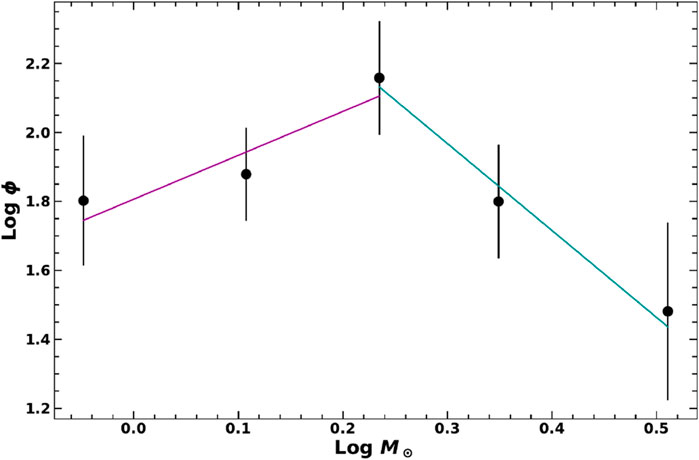
Figure 4. Mass function distribution for the Be 65 cluster. The error bars represented with MF data points (filled black dots) are
3.4 Identification of variables
Our long-term photometric monitoring of Be 65 is ideal for identifying this region’s long-period and short-term variables. We have used differential photometric techniques to identify variable stars in the field. This technique is particularly useful for removing the star’s brightness variation due to atmospheric conditions on the night of observation and instrumental signatures. It is important to note that the error in calculated magnitude increases as the stars become fainter. Therefore, a brighter star cannot be used as a comparison star for the faint stars, as larger magnitude errors can obscure the star’s variation. To overcome this, we divided all the stars into different magnitude bins with a bin size of 1 mag. We computed the magnitude differences for each magnitude bin for every possible pair of stars in a frame. We selected the comparison stars for which the standard deviation in the magnitude difference was the minimum. After selecting the comparison star, we determined the magnitude difference between the comparison star and target stars in each magnitude bin. Subsequently, we generated light curves (LCs) by plotting the resulting
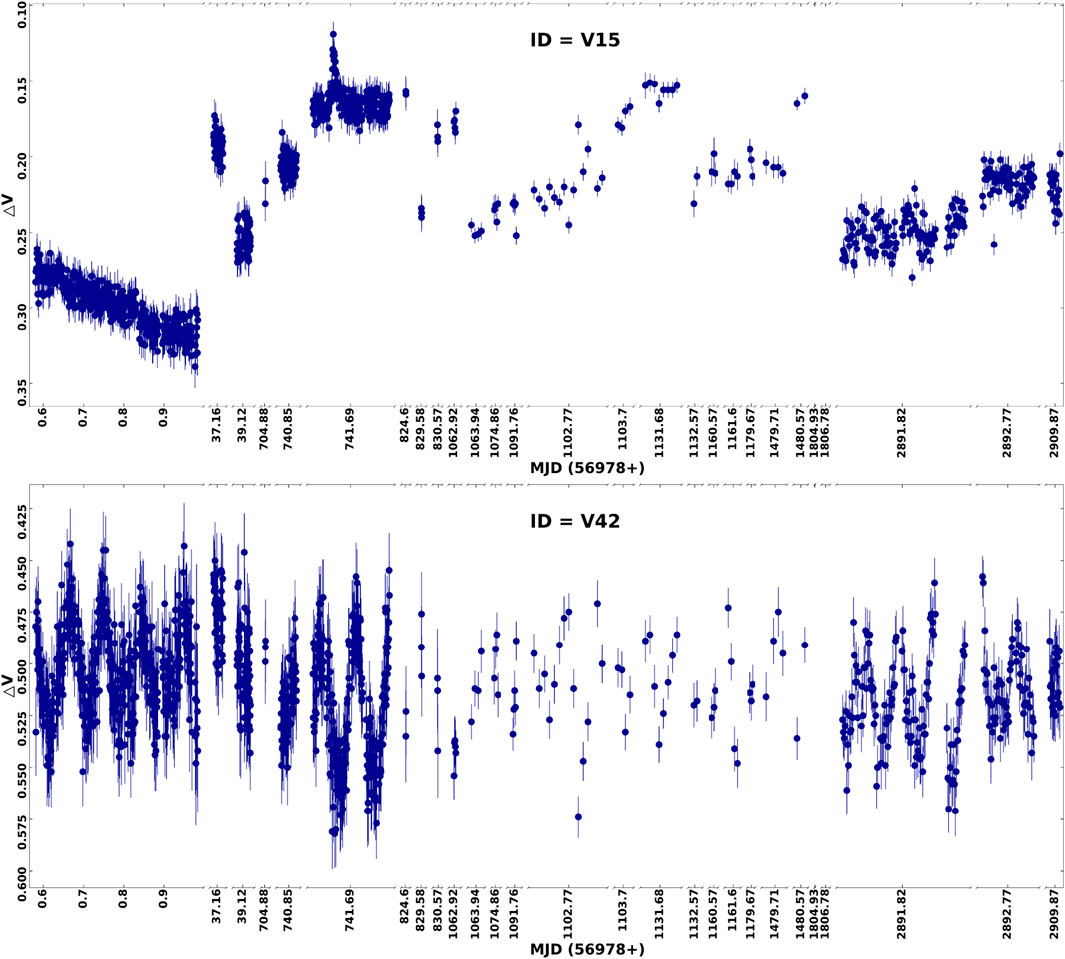
Figure 5. Samples of the light curves: in the upper panel, the light curve of a non-periodic variable (V15) is shown. The light curve of a periodic variable (V42) is shown in the lower panel.
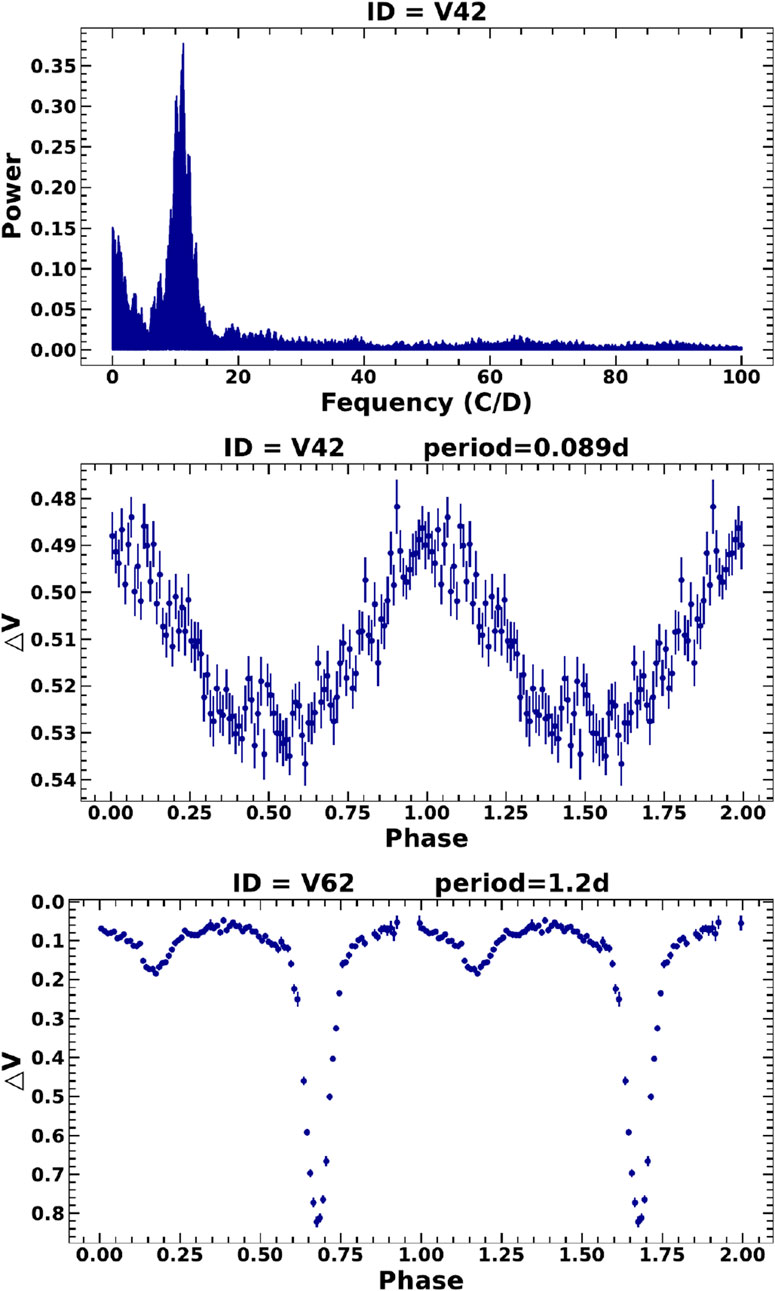
Figure 6. Upper panel: The power spectrum of a periodic star (V42) derived using Lomb-Scargle periodogram (Lomb, 1976; Scargle, 1982). Middle panel: the phase-folded light curve of the same periodic star (V42) using the period as 0.089 days. Lower panel: The phase-folded light curve of a detected eclipsing binary (V62); approx. 1.2 days is used as a period to fold the light curve.
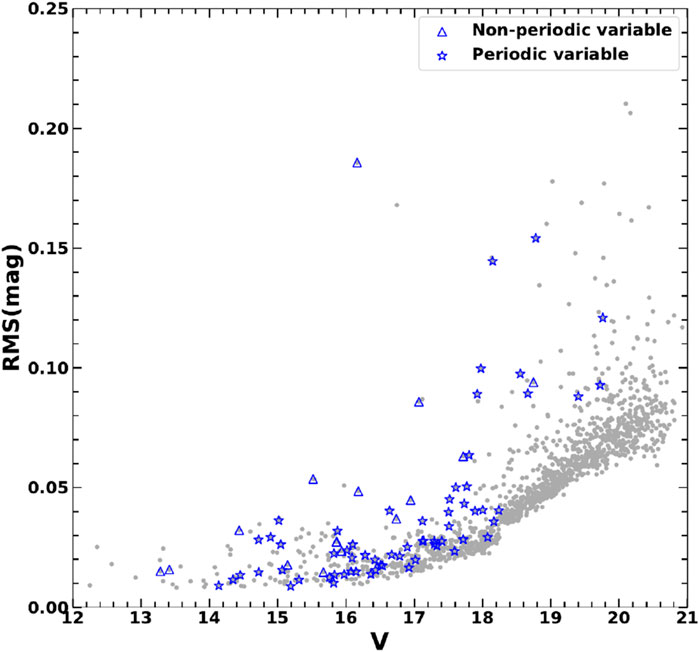
Figure 7. RMS dispersion of magnitudes for all the target stars as a function of their V magnitude. The grey dots represent the stars in FoV towards the Be 65 cluster, while the blue open triangles and stars represent non-periodic and periodic variables towards the Be 65 cluster.
4 Results
4.1 Physical properties of the Be 65 cluster
Using the surface density estimates derived from Equation 1, the peak density is found to be located at
The minimum reddening value
Although there is a scatter in the MF distribution, a distinct change in slope can be observed at log
4.2 Dynamical state of the cluster
In our study, we used the minimum spanning tree (MST5) method (Allison et al., 2009; Olczak et al., 2011; Dib et al., 2018), to investigate mass segregation within the Be 65 cluster region. We used the mass segregation ratio (MSR,
One of the consequences of the mass segregation process is the increased vulnerability of the lowest-mass members to be ejected from the system (e.g., see Mathieu, 1984). Thus, we estimated the tidal radius ‘
Where
4.3 Physical properties of the variables
Figure 8 shows the distribution of amplitude and period of the variables identified in the present study. The amplitude and period of the periodic stars range from
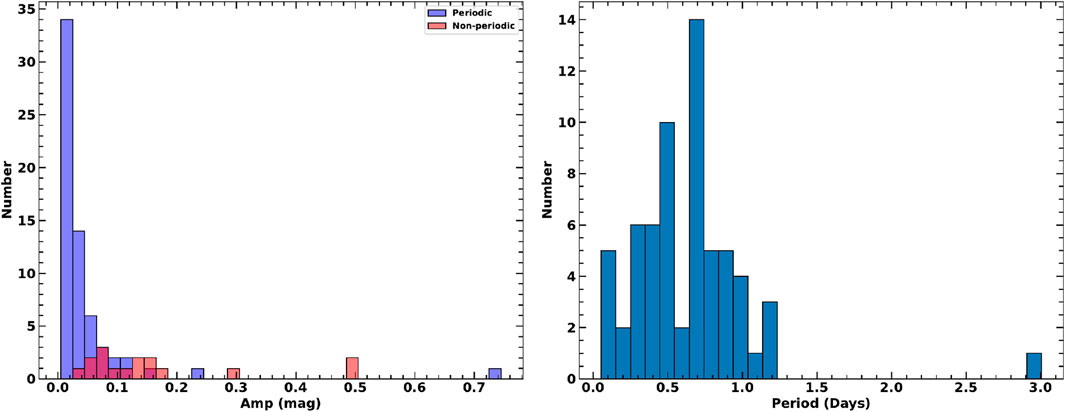
Figure 8. In the left panel, the histogram shows the amplitude distribution of variable stars. The right panel shows the period distribution of periodic stars.
The physical parameters, such as the age and mass of the cluster member variables, can be easily derived from their position in the CMD. However, it can’t be done for other field variables as we don’t know their exact extinction and distance. Thus, we utilized the Green et al. (2019) map to determine the extinction values for these field variables. Subsequently, employing these extinction values along with the distances obtained from Bailer-Jones et al. (2021), we derived the absolute magnitude in the V band
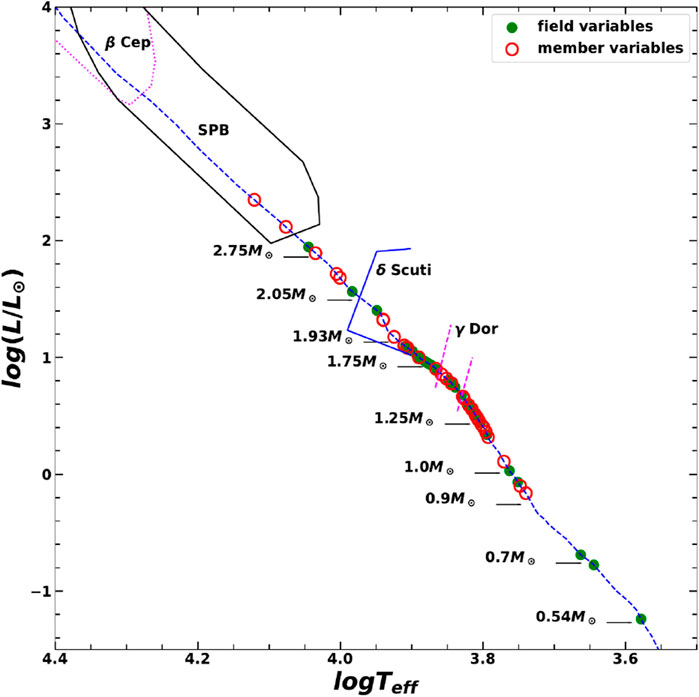
Figure 9. Hertzsprung-Russell (log
4.4 Classification of variables
We have not detected any PMS signatures in the identified variables, as outlined in the study by Gutermuth et al. (2009); Koenig and Leisawitz (2014); Sharma et al. (2016). Thus, considering the identified variable as MS variables, we tried to classify these variables into various known type classes. Our approach involved classifying these stars based on their period, variability amplitude, position in the HR diagram, and the shape of their LCs.
4.4.1 Pulsating variables
In our study, we identified two stars with periodic variations (V2 and V5) positioned within the SPB region on the HR diagram (refer to Figure 9). These stars have periods of 0.5058
4.4.2 Non-pulsating variables
A group of five stars, V7, V10, V13, V22, and V55, are located within the gap between the SPB and
4.4.3 Eclipsing binary
The shape of the LC of one identified periodic variable, V62, suggests that this variable is the probable candidate for an eclipsing binary (EB). Based on the distinct primary and secondary minima observed in the LC of V62, it can be concluded that this star is a detached binary system. The period of the complete cycle for this EB is calculated as 1.2 days. The brightness variation during primary and secondary minima is calculated as approximately 800 mmag and 150 mmag, respectively. The phase-folded LC is given in the lower panel of Figure 6. This star is listed in VizieR Online Data Catalog: KISOGP (Ren et al., 2021) as an Algol-type eclipsing binary with a period 1.2003209
4.4.4 Rotating variables
This section discusses those variable stars that are located below the
4.4.5 Non-periodic variables
The sixteen identified variables are marked as non-periodic in the present study. Two are classified as cluster members, and fourteen are field populations (see Section 3.4). The non-member variables show amplitudes ranging from
One periodic variable star, V26, could not be classified due to the lack of distance information in Bailer-Jones et al., 2021. Therefore, we have labeled it as “Periodic/Field” in Table 2.
5 Summary and conclusion
We have used deep optical photometric data from the ARIES telescopes to study the physical properties of a poorly studied cluster, Be 65. The shape of this cluster is more or less circular, with an aspect ratio of 1.1. The center of the cluster is found to be at
Using a homogeneous decade-long baseline optical data, we also searched for the variables in the direction of the Be 65 cluster region. We have identified 64 periodic and 16 non-periodic stars, with periods ranging from 0.05 days to 3 days and amplitudes ranging from approximately 8 mmag to 742 mmag. Out of them, 35 are found to be members of the cluster Be 65, and the remaining ones are the field population. Using the position in the HR diagram and the shape of the LCs, we have characterized the variability properties of the periodic stars. Of them, 31 are categorized as main-sequence pulsating variables of different types, such as SPB (2),
Data availability statement
The raw data supporting the conclusions of this article will be made available by the authors, without undue reservation.
Author contributions
TC: Conceptualization, Data curation, Formal Analysis, Investigation, Methodology, Software, Writing – original draft. SS: Conceptualization, Data curation, Investigation, Methodology, Supervision, Writing – review and editing. KS: Writing – review and editing. JP: Formal Analysis, Investigation, Writing – review and editing. AV: Data curation, Validation, Writing – review and editing. HK: Data curation, Formal Analysis, Investigation, Methodology, Software, Writing – review and editing. Mamta: Data curation, Writing – review and editing. MC: Data curation, Writing – review and editing. DO: Conceptualization, Writing – review and editing. AS: Supervision, Writing – review and editing.
Funding
The author(s) declare that financial support was received for the research and/or publication of this article. DO acknowledges the support of the Department of Atomic Energy, Government of India, under project identification no. RTI 4002. AV acknowledges the financial support of DST-INSPIRE (No.: DST/INSPIRE Fellowship/2019/IF190550).
Acknowledgments
The observations reported in this paper were obtained by using the 1.3 m Devasthal Fast Optical Telescope (DFOT) and 1.04 m Sampurnand Telescope (ST), Nainital, India. This work made use of data from the Two Micron All Sky Survey (a joint project of the University of Massachusetts and the Infrared Processing and Analysis Center/California Institute of Technology, funded by the National Aeronautics and Space Administration and the National Science Foundation), and archival data obtained with the Spitzer Space Telescope and Wide Infrared Survey Explorer (operated by the Jet Propulsion Laboratory, California Institute of Technology, under contract with the NASA. This publication also made use of data from the European Space Agency (ESA) mission Gaia (https://www.cosmos.esa.int/gaia), processed by the Gaia Data Processing and Analysis Consortium (DPAC, https://www.cosmos.esa.int/web/gaia/dpac/consortium). We thank both the referees for their constructive suggestions, which significantly improved the clarity of the paper.
Conflict of interest
The authors declare that the research was conducted in the absence of any commercial or financial relationships that could be construed as a potential conflict of interest.
Generative AI statement
The author(s) declare that no Generative AI was used in the creation of this manuscript.
Publisher’s note
All claims expressed in this article are solely those of the authors and do not necessarily represent those of their affiliated organizations, or those of the publisher, the editors and the reviewers. Any product that may be evaluated in this article, or claim that may be made by its manufacturer, is not guaranteed or endorsed by the publisher.
Supplementary material
The Supplementary Material for this article can be found online at: https://www.frontiersin.org/articles/10.3389/fspas.2025.1608196/full#supplementary-material
Footnotes
1https://astro.dur.ac.uk/∼pdraper/gaia/gaia.html
2https://www.cosmos.esa.int/web/gaia/data-release-3
3Convex hull is an irregular polygon enclosing all points in a grouping with internal angles between two contiguous sides of less than 180
4Barber, C. B., D.P. Dobkin, and H.T. Huhdanpaa,” The Quickhull Algorithm for Convex Hulls,” ACM Transactions on Mathematical Software, 22(4):469-483 December 1996, www.qhull.org.
5The MST is a network of branches that connects a set of points while minimizing the total branch length and avoiding any loops (Battinelli, 1991). This algorithm has lately become a popular tool to search for clusters of stars since it is independent from the star’s density number (Gutermuth et al., 2009; Chavarría et al., 2014; Sharma et al., 2016).
References
Allen, L., Megeath, S. T., Gutermuth, R., Myers, P. C., Wolk, S., Adams, F. C., et al. (2007). “The structure and evolution of young stellar clusters,” in Protostars and planets V. Editors B. Reipurth, D. Jewitt, and K. Keil, 361. doi:10.48550/arXiv.astro-ph/0603096
Allison, R. J., Goodwin, S. P., Parker, R. J., Portegies Zwart, S. F., de Grijs, R., and Kouwenhoven, M. B. N. (2009). Using the minimum spanning tree to trace mass segregation. MNRAS 395, 1449–1454. doi:10.1111/j.1365-2966.2009.14508.x
Bailer-Jones, C. A. L., Rybizki, J., Fouesneau, M., Demleitner, M., and Andrae, R. (2021). Estimating distances from parallaxes. V. Geometric and photogeometric distances to 1.47 billion stars in Gaia early data release 3. AJ 161. Astron. J. 161, 147. doi:10.3847/1538-3881/abd806
Balona, L. A., Pigulski, A., De Cat, P., Handler, G., Gutiérrez-Soto, J., Engelbrecht, C. A., et al. (2011). Kepler observations of the variability in B-type stars. MNRAS 413, 2403–2420. doi:10.1111/j.1365-2966.2011.18311.x
Battinelli, P. (1991). A new identification technique for OB associations: OB associations in the Small Magellanic Cloud. A&A 244, 69.
Binney, J., and Tremaine, S. (1987). Galactic dynamics. Princeton, NJ, United States: Princeton University Press.
Bonatto, C., Kerber, L. O., Bica, E., and Santiago, B. X. (2006). Probing disk properties with open clusters. A&A 446, 121–135. doi:10.1051/0004-6361:20053573
Brinkmann, N., Banerjee, S., Motwani, B., and Kroupa, P. (2017). The bound fraction of young star clusters. A&A 600, A49. doi:10.1051/0004-6361/201629312
Chahal, D., de Grijs, R., Kamath, D., and Chen, X. (2022). Statistics of BY Draconis chromospheric variable stars. MNRAS 514, 4932–4943. doi:10.1093/mnras/stac1660
Chavarría, L., Allen, L., Brunt, C., Hora, J. L., Muench, A., and Fazio, G. (2014). A multiwavelength study of embedded clusters in W5-east, NGC 7538, S235, S252 and S254-S258. MNRAS 439, 3719–3754. doi:10.1093/mnras/stu224
Chehlaeh, N., Mkrtichian, D., Lampens, P., Komonjinda, S., Kim, S.-L., Van Cauteren, P., et al. (2018). Photometric study and search for variable stars in the intermediate-age open cluster NGC 2126. Mon. Notices R. Astronomical Soc. 480, 1850–1863. doi:10.1093/mnras/sty1906
Cutri, R. M., Skrutskie, M. F., van Dyk, S., Beichman, C. A., Carpenter, J. M., Chester, T., et al. (2003). VizieR online data catalog: 2MASS all-sky catalog of point sources (Cutri+ 2003). VizieR Online Data Cat, II/246.
Dib, S., Gutkin, J., Brandner, W., and Basu, S. (2013). Feedback-regulated star formation - II. Dual constraints on the SFE and the age spread of stars in massive clusters. MNRAS 436, 3727–3740. doi:10.1093/mnras/stt1857
Dib, S., Piau, L., Mohanty, S., and Braine, J. (2011). Star formation efficiency as a function of metallicity: from star clusters to galaxies. MNRAS 415, 3439–3454. doi:10.1111/j.1365-2966.2011.18966.x
Dib, S., Schmeja, S., and Parker, R. J. (2018). Structure and mass segregation in Galactic stellar clusters. MNRAS 473, 849–859. doi:10.1093/mnras/stx2413
Fedurco, M., Paunzen, E., Hümmerich, S., Bernhard, K., and Parimucha, Š. (2020). Pulsational properties of ten new slowly pulsating B stars. A&A 633, A122. doi:10.1051/0004-6361/201935478
Fleck, J. J., Boily, C. M., Lançon, A., and Deiters, S. (2006). On the mass of dense star clusters in starburst galaxies from spectrophotometry. MNRAS 369, 1392–1406. doi:10.1111/j.1365-2966.2006.10390.x
Gaia Collaboration (2022). VizieR online data catalog: Gaia DR3 Part 4. Var. (Gaia Collab. 2022). VizieR Online Data Catalog, I/358.
Gaia Collaboration Vallenari, A., Brown, A. G. A., Prusti, T., de Bruijne, J. H. J., Arenou, F., et al. (2023). Gaia data release 3 - summary of the content and survey properties. A&A 674, A1. doi:10.1051/0004-6361/202243940
Gao, X., Chen, X., Wang, S., and Liu, J. (2025). Classification of periodic variable stars from TESS. ApJS 276, 57. doi:10.3847/1538-4365/ad9dd6
Gautschy, A., and Saio, H. (1993). On non-radial oscillations of B-type stars. MNRAS 262, 213–219. doi:10.1093/mnras/262.1.213
Girard, T. M., Grundy, W. M., Lopez, C. E., and van Altena, W. F. (1989). Relative proper motions and the stellar velocity dispersion of the open cluster M67. AJ 98, 227. doi:10.1086/115139
Grasha, K., Calzetti, D., Bittle, L., Johnson, K. E., Donovan Meyer, J., Kennicutt, R. C., et al. (2018). Connecting young star clusters to CO molecular gas in NGC 7793 with ALMA-LEGUS. MNRAS 481, 1016–1027. doi:10.1093/mnras/sty2154
Grasha, K., Elmegreen, B. G., Calzetti, D., Adamo, A., Aloisi, A., Bright, S. N., et al. (2017). Hierarchical star formation in turbulent media: evidence from young star clusters. ApJ 842, 25. doi:10.3847/1538-4357/aa740b
Green, G. M., Schlafly, E., Zucker, C., Speagle, J. S., and Finkbeiner, D. (2019). A 3D dust map based on Gaia, pan-STARRS 1, and 2MASS. ApJ 887, 93. doi:10.3847/1538-4357/ab5362
Gutermuth, R. A., Megeath, S. T., Myers, P. C., Allen, L. E., Pipher, J. L., and Fazio, G. G. (2009). A spitzer survey of young stellar clusters within one kiloparsec of the sun: cluster core extraction and basic structural analysis. ApJS 184, 18–83. doi:10.1088/0067-0049/184/1/18
Gutermuth, R. A., Megeath, S. T., Pipher, J. L., Williams, J. P., Allen, L. E., Myers, P. C., et al. (2005). The initial configuration of young stellar clusters: a K-band number counts analysis of the surface density of stars. ApJ 632, 397–420. doi:10.1086/432460
Handler and Meingast Meingast, S. (2011). New β cephei stars in the young open cluster ngc 637. A&A 533, A70. doi:10.1051/0004-6361/201116874
Ibanoglu, C., Çakırlı, Ö., and Sipahi, E. (2018). The first comprehensive catalog of γ Dor pulsators and their characteristics. New A 62, 70–84. doi:10.1016/j.newast.2018.01.004
Jose, J., Pandey, A. K., Ojha, D. K., Ogura, K., Chen, W. P., Bhatt, B. C., et al. (2008). Stellar contents and star formation in the young open cluster Stock 8. Mon. Notices R. Astronomical Soc. 384, 1675–1700. doi:10.1111/j.1365-2966.2007.12825.x
Kang, Y. B., Kim, S. L., Rey, S. C., Lee, C. U., Kim, Y. H., Koo, J. R., et al. (2007). Variable stars in the open cluster NGC 2099 (M37). PASP 119, 239–250. doi:10.1086/513883
Kaur, H., Sharma, S., Dewangan, L. K., Ojha, D. K., Durgapal, A., and Panwar, N. (2020). Unveiling the physical conditions in NGC 6910. ApJ 896, 29. doi:10.3847/1538-4357/ab9122
Kaur, H., Sharma, S., Durgapal, A., Dewangan, L. K., Verma, A., Panwar, N., et al. (2023). Structural analysis of open cluster Bochum 2. J. Astrophysics Astronomy 44, 66. doi:10.1007/s12036-023-09953-9
Kim, S. L., Chun, M. Y., Park, B. G., Lee, S. H., Sung, H., Ann, H. B., et al. (2001). Search for short-period variable stars in the open cluster NGC 2301. A&A 371, 571–578. doi:10.1051/0004-6361:20010403
Koenig, X. P., and Leisawitz, D. T. (2014). A classification scheme for young stellar objects using the wide-field infrared survey explorer AllWISE catalog: revealing low-density star formation in the outer galaxy. ApJ 791, 131. doi:10.1088/0004-637X/791/2/131
Kroupa, P. (2002). The initial mass function of stars: evidence for uniformity in variable systems. Science 295, 82–91. doi:10.1126/science.1067524
Kruijssen, J. M. D. (2012). On the fraction of star formation occurring in bound stellar clusters. MNRAS 426, 3008–3040. doi:10.1111/j.1365-2966.2012.21923.x
Lada, C. J., and Lada, E. A. (2003). Embedded clusters in molecular clouds. Annu. Rev. Astronomy Astrophysics 41, 57–115. doi:10.1146/annurev.astro.41.011802.094844
Landolt, A. U. (1992). UBVRI photometric standard stars in the magnitude range 11.5-16.0 around the celestial equator. AJ 104, 340. doi:10.1086/116242
Lata, S., Pandey, A., Sharma, S., Bonatto, C., and Yadav, R. K. (2014a). Photometric study of five open star clusters. New Astron. 26, 77–85. doi:10.1016/j.newast.2013.06.003
Lata, S., Pandey, A. K., Kesh Yadav, R., Richichi, A., Irawati, P., Panwar, N., et al. (2019). Short-period variable stars in young open cluster Stock 8. AJ 158, 68. doi:10.3847/1538-3881/ab298c
Lata, S., Yadav, R. K., Pandey, A. K., Richichi, A., Eswaraiah, C., Kumar, B., et al. (2014b). Main-sequence variable stars in young open cluster NGC 1893. MNRAS 442, 273–284. doi:10.1093/mnras/stu726
Lebzelter, T., Mowlavi, N., Lecoeur-Taibi, I., Trabucchi, M., Audard, M., García-Lario, P., et al. (2023). Gaia Data Release 3. The second Gaia catalogue of long-period variable candidates. A&A 674, A15. doi:10.1051/0004-6361/202244241
Lomb, N. R. (1976). Least-squares frequency analysis of unequally spaced data. Ap&SS 39, 447–462. doi:10.1007/BF00648343
Martinez-Vazquez, C. E., Salinas, R., Vivas, A. K., and Catelan, M. (2023). “Breaking the laws”: a segmented period-luminosity relation in delta Scuti stars. Am. Astronomical Soc. Meet. Abstr. 241, 10.
Mathieu, R. D. (1984). The structure and dynamics of the open cluster M 11. ApJ 284, 643–662. doi:10.1086/162447
Messina, S., Distefano, E., Parihar, P., Kang, Y. B., Kim, S.-L., Rey, S.-C., et al. (2008). RACE-OC project: rotation and variability in the open cluster NGC 2099 (M 37). A&A 483, 253–262. doi:10.1051/0004-6361:20079216
Miglio, A., Montalbán, J., and Dupret, M. A. (2007). Revised instability domains of SPB and β Cephei stars. Commun. Asteroseismol. 151, 48–56. doi:10.1553/cia151s48
Mowlavi, N., Barblan, F., Saesen, S., and Eyer, L. (2013). Stellar variability in open clusters. I. A new class of variable stars in NGC 3766. A&A 554, A108. doi:10.1051/0004-6361/201321065
Mullen, J. P., Marengo, M., Martínez-Vázquez, C. E., Chaboyer, B., Bono, G., Braga, V. F., et al. (2023). RR Lyrae mid-infrared period-luminosity-metallicity and period-Wesenheit-Metallicity relations based on Gaia DR3 parallaxes. ApJ 945, 83. doi:10.3847/1538-4357/acb20a
Olczak, C., Spurzem, R., and Henning, T. (2011). A highly efficient measure of mass segregation in star clusters. A&A 532, A119. doi:10.1051/0004-6361/201116902
Pandey, R., Sharma, S., Panwar, N., Dewangan, L. K., Ojha, D. K., Bisen, D. P., et al. (2020). Stellar cores in the sh 2-305 H II region. ApJ 891, 81. doi:10.3847/1538-4357/ab6dc7
Parker, R. J., and Dale, J. E. (2013). Imprints of feedback in young gasless clusters? MNRAS 432, 986–997. doi:10.1093/mnras/stt517
Parker, R. J., and Meyer, M. R. (2012). Characterizing the dynamical state of star clusters from snapshots of their spatial distributions. MNRAS 427, 637–650. doi:10.1111/j.1365-2966.2012.21851.x
Pastorelli, G., Marigo, P., Girardi, L., Chen, Y., Rubele, S., Trabucchi, M., et al. (2019). Constraining the thermally pulsing asymptotic giant branch phase with resolved stellar populations in the Small Magellanic Cloud. MNRAS 485, 5666–5692. doi:10.1093/mnras/stz725
Pecaut, M. J., and Mamajek, E. E. (2013). Intrinsic colors, temperatures, and bolometric corrections of pre-main-sequence stars. ApJS 208, 9. doi:10.1088/0067-0049/208/1/9
Pfalzner, S., and Kaczmarek, T. (2013). The expansion of massive young star clusters - observation meets theory. A&A 559, A38. doi:10.1051/0004-6361/201322134
Phelps, R. L., and Janes, K. A. (1994). Young open clusters as probes of the star formation process. 1: an atlas of open cluster photometry. ApJS 90, 31. doi:10.1086/191857
Pietrukowicz, P., Soszyński, I., Netzel, H., Wrona, M., Udalski, A., Szymański, M. K., et al. (2020). Over 10000 δ Scuti stars toward the galactic bulge from OGLE-IV. Acta Astron 70, 241–263. doi:10.32023/0001-5237/70.4.1
Rangwal, G., Yadav, R. K. S., Bisht, D., Durgapal, A., and Sariya, D. P. (2023). Investigating kinematics and dynamics of three open clusters towards Galactic anticentre. Mon. Notices R. Astronomical Soc. 523, 1867–1884. doi:10.1093/mnras/stad1517
Ren, F., de Grijs, R., Zhang, H., Deng, L., Chen, X., Matsunaga, N., et al. (2021). VizieR online data catalog: KISOGP: 7055 eclipsing binaries with KWFC (Ren+, 2021). Strasbourg, France: VizieR Online Data Catalog. doi:10.26093/cds/vizier.51610176
Ruprecht, J. (1966). Classification of open star clusters. Bull. Astronomical Institutes Czechoslov. 17, 33.
Sagar, R., Kumar, B., Omar, A., and Joshi, Y. C. (2012). New optical telescopes at Devasthal observatory: 1.3-m installed and 3.6-m upcoming. Astronomical Soc. India Conf. Ser. 4, 173. doi:10.1117/12.925634
Sagar, R., and Richtler, T. (1991). Mass functions of five Large Magellanic Cloud star clusters. A&A 250, 324.
Sánchez Arias, J. P., Córsico, A. H., and Althaus, L. G. (2017). Asteroseismology of hybrid δ Scuti-γ Doradus pulsating stars. A&A 597, A29. doi:10.1051/0004-6361/201629126
Scargle, J. D. (1982). Studies in astronomical time series analysis. II. Statistical aspects of spectral analysis of unevenly spaced data. ApJ 263, 835–853. doi:10.1086/160554
Schmeja, S., and Klessen, R. S. (2006). Evolving structures of star-forming clusters. A&A 449, 151–159. doi:10.1051/0004-6361:20054464
Sharma, S., Dewangan, L., Panwar, N., Kaur, H., Ojha, D. K., Yadav, R., et al. (2023). Teutsch 76: a deep near-infrared study. J. Astrophysics Astronomy 44, 46. doi:10.1007/s12036-023-09936-w
Sharma, S., Ghosh, A., Ojha, D. K., Pandey, R., Sinha, T., Pandey, A. K., et al. (2020). The disintegrating old open cluster Czernik 3. MNRAS 498, 2309–2322. doi:10.1093/mnras/staa2412
Sharma, S., Pandey, A. K., Borissova, J., Ojha, D. K., Ivanov, V. D., Ogura, K., et al. (2016). Structural studies of eight bright rimmed clouds in the southern hemisphere. Astronomical J. 151, 126. doi:10.3847/0004-6256/151/5/126
Sharma, S., Pandey, A. K., Ogura, K., Aoki, T., Pandey, K., Sandhu, T. S., et al. (2008). Mass functions and photometric binaries in nine open clusters. Astronomical J. 135, 1934–1945. doi:10.1088/0004-6256/135/5/1934
Sharma, S., Pandey, A. K., Ojha, D. K., Chen, W. P., Ghosh, S. K., Bhatt, B. C., et al. (2007). Star formation in young star cluster NGC 1893. Mon. Notices R. Astronomical Soc. 380, 1141–1160. doi:10.1111/j.1365-2966.2007.12156.x
Sharma, S., Verma, A., Mallick, K., Dewangan, L. K., Kaur, H., Yadav, R. K., et al. (2024). Cluster Formation in a filamentary cloud: the case of the stellar cluster NGC 2316. AJ 167, 106. doi:10.3847/1538-3881/ad19cd
Skrutskie, M. F., Cutri, R. M., Stiening, R., Weinberg, M. D., Schneider, S., Carpenter, J. M., et al. (2006). The two Micron all Sky survey (2MASS). AJ 131, 1163–1183. doi:10.1086/498708
Soszyński, I., Pietrukowicz, P., Skowron, J., Udalski, A., Szymański, M. K., Skowron, D. M., et al. (2021). Over 24 000 δ Scuti stars in the galactic bulge and disk from the OGLE survey. Acta Astron 71, 189–204. doi:10.32023/0001-5237/71.3.1
Spitzer, L., and Harm, R. (1958). Evaporation of stars from isolated clusters. ApJ 127, 544. doi:10.1086/146486
Stankov, A., and Handler, G. (2005). Catalog of galactic β cephei stars. ApJS 158, 193–216. doi:10.1086/429408
Stetson, P. B. (1987). DAOPHOT: a computer program for crowded-field stellar photometry. PASP 99, 191. doi:10.1086/131977
Stetson, P. B. (1992). “More experiments with DAOPHOT II and WF/PC images,” in Astronomical data analysis software and systems I. Editors D. M. Worrall, C. Biemesderfer, and J. Barnes (San Francisco, CA: Astronomical Society of the Pacific Conference Series), 25, 297.
Szewczuk, W., and Daszyńska-Daszkiewicz, J. (2017). Domains of pulsational instability of low-frequency modes in rotating upper main sequence stars. MNRAS 469, 13–46. doi:10.1093/mnras/stx738
Tang, S.-Y., Pang, X., Yuan, Z., Chen, W. P., Hong, J., Goldman, B., et al. (2019). Discovery of tidal tails in disrupting open clusters: coma berenices and a neighbor stellar group. ApJ 877, 12. doi:10.3847/1538-4357/ab13b0
Verma, A., Sharma, S., Dewangan, L., Pandey, R., Baug, T., Ojha, D. K., et al. (2023). Kronberger 55: a candidate for end-dominated collapse scenario. J. Astrophysics Astronomy 44, 52. doi:10.1007/s12036-023-09932-0
Warner, P. B., Kaye, A. B., and Guzik, J. A. (2003). A theoretical γ Doradus instability strip. ApJ 593, 1049–1055. doi:10.1086/376727
Keywords: Galaxies, star clusters, general-(ISM), dust, extinction-stars, variables, general-(stars), Hertzsprung-Russell and color-magnitude diagrams
Citation: Chand T, Sharma S, Singh K, Pandey J, Verma A, Kaur H, Mamta , Chakraborty M, Ojha DK and Singh AK (2025) Long-term investigation of an open cluster Berkeley 65. Front. Astron. Space Sci. 12:1608196. doi: 10.3389/fspas.2025.1608196
Received: 08 April 2025; Accepted: 29 May 2025;
Published: 18 June 2025.
Edited by:
Anupam Bhardwaj, Savitribai Phule Pune University, IndiaReviewed by:
Milan Stojanovic, Astronomical Observatory, SerbiaAlok Durgapal, Kumaun University, India
Copyright © 2025 Chand, Sharma, Singh, Pandey, Verma, Kaur, Mamta, Chakraborty, Ojha and Singh. This is an open-access article distributed under the terms of the Creative Commons Attribution License (CC BY). The use, distribution or reproduction in other forums is permitted, provided the original author(s) and the copyright owner(s) are credited and that the original publication in this journal is cited, in accordance with accepted academic practice. No use, distribution or reproduction is permitted which does not comply with these terms.
*Correspondence: Tarak Chand, dGFyYWtjaGFuZHNAZ21haWwuY29t, dGFyYWtjaGFuZEBhcmllcy5yZXMuaW4=; Saurabh Sharma, c2F1cmFiaDE3NUBnbWFpbC5jb20=, c2F1cmFiaEBhcmllcy5yZXMuaW4=
 Tarak Chand
Tarak Chand Saurabh Sharma1*
Saurabh Sharma1* Koshvendra Singh
Koshvendra Singh Aayushi Verma
Aayushi Verma Harmeen Kaur
Harmeen Kaur Mamta
Mamta Manojit Chakraborty
Manojit Chakraborty